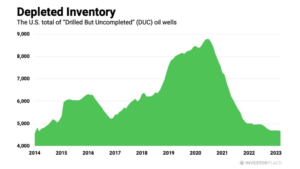Hello, Reader.
Amidst all the well-deserved hoopla for AI plays, most non–AI stocks are receiving little attention from investors.
Energy stocks fall into that bucket, but I believe they deserve a fresh look.
Although the energy sector has been “dead money” for more than a year, it was very much alive prior to that. In fact, most investors might be shocked to learn that the S&P Oil & Gas Exploration & Production ETF (XOP), which tracks energy stocks, has delivered larger gains than AI juggernauts like Amazon.com Inc. (AMZN) over the previous two-, three-, and four-year timespans.
In that context, the last year looks like a pause in the action, not the end of oil’s bullish trend.
The energy sector could attract renewed attention over the coming months, as bullish conditions in the industry produce firming oil and gas prices.
Energy stocks, in general, are reflecting soft demand and soft prices for oil and gas. Therefore, if demand and prices improve even a little, energy stocks could deliver surprisingly strong gains. That’s an attractive bet.
At present, global crude supply is roughly in balance with global demand. Despite this momentary parity, demand could soon begin outpacing supply, thanks to reviving economic growth worldwide.
Here in the States, signs of strengthening economic conditions seem to pop up daily. Friday morning, for example, the Bureau of Labor Statistics announced shockingly large payroll growth in January of more than 350,000 jobs.
Reflecting these positive economic signals, world oil consumption in December topped production for the first time in more than a year. This trend could gain momentum over the coming months – not only because of improving demand, but also because of sluggish-to-negative supply growth.
For starters, U.S. crude inventories have plummeted to a 49-year low! Turning to U.S. production, we find similarly surprising and bullish data points.
The number of Drilled But Uncompleted (DUC) wells has dropped to the lowest level in more than a decade. A DUC well is one that has been drilled, but not yet been brought into production. In other words, the well has been drilled to the target depth, but the completion process has not yet been carried out.
Because an oil company can bring DUC wells into production quickly, they provide a great way to capitalize on oil price spikes without having to make sizeable new investments. Oil companies have been doing exactly that during the last four years.
As a result, the remaining inventory of DUC wells has dropped to a 10-year low. These low inventories mean that U.S. oil companies have exhausted most of the “easy money” they could make from oil price spikes.
Going forward, therefore, they would need to boost spending on new drilling activity, but that isn’t happening. The number of active oil-drilling rigs in the U.S. has been falling for more than a year and currently sits 26% below the 10-year average number.
In other words, there is no significant U.S. supply boost on the horizon. That’s an important factor in the global crude market. Remember, the U.S. has supplied almost all of the world’s crude production growth during the last decade, not OPEC. In fact, OPEC production has fallen 22% during the last seven years.
A fresh wave of investment in exploration and production (E&P) could boost output somewhat, but very few oil companies are expressing any intention to do so.
Rising crude demand, coupled with flat supply growth, provides ample reason to take another swing at the oil market.
In the past, we’ve seen America’s richest “one-percenters” flock to… and emerge from… places like Houston and Dallas, during the Texas oil boom.
In fact, Houston was once just a muddy port town, plagued by yellow fever.
Then, in 1901 a Texas drilling rig broke through into a massive oil deposit on Spindletop Hill… and sent a gusher of crude soaring 150 feet into the air.
In Texas terms, Houston was not too far down the highway from Spindletop. And it had a deep seaport, which made it perfect for shipping all that new oil.
Soon, Houston was thriving. It became a beacon for the rest of the world. Rigs went up. So did refineries. And investors poured in with capital, looking to make their fortunes. And the rich oil made these investors, well, richer.
So, this brings up the question: What are rich Americans doing with their money right now?
The truth is that some of these “one-percenters” have been quietly funneling billions of dollars into a surprising new market…
Which is emerging at the heart of an even more surprising all-American new megatrend. And frankly, the outcome of what they’re doing could prove game-changing for the entire U.S. economy.
So much so, I’ve taken to calling this phenomenon “America 2.0.” And what’s really going to surprise you is where this is happening…
Because it’s not taking place in Silicon Valley.
And it’s not centered around Wall Street or Manhattan.
Instead, this new wealth mecca is emerging in the middle of the American heartland.
I even took a film crew there to show you what’s happening. Click here to learn more.
Regards,
Eric


